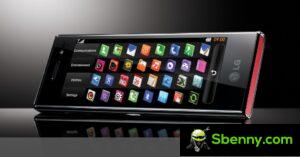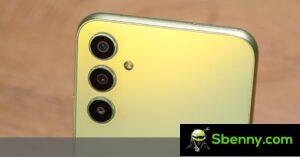Even though the iPhone Pro models sell more, many people still buy the standard iPhone models. The update cycle for iPhones is longer than that of Android phones and is a testament to how well these devices are made from hardware to software and back again.
If you still have an older iPhone, you may be wondering whether to upgrade to the iPhone 14 or 15 (both are still officially on sale by Apple). Well, look no further; we have a full comparison planned.
The leap from the iPhone 14 to the iPhone 15 is one of the biggest we’ve seen in recent memory. The iPhone 15 has a new, much brighter display, a new, much better 48MP main camera, and has switched to using a USB Type-C port, just to name a few things.
For starters, you can compare the full spec sheets here or continue directly with our editor’s rating below.
Size comparison
The iPhone 15 and iPhone 14 have an almost identical overall footprint. You’d honestly be hard-pressed to tell the two apart just by going fit alone.
The new colors are more of a giveaway, but a quick look at the shape of the display notch makes the new device instantly recognisable. Dynamic Island, introduced in Pro models last year, has finally made its way to the standard iPhone 15, and we like the more modern look.
Both phones have a 6.1-inch panel, but the new iPhone 15 has a slightly higher resolution and a better screen-to-body ratio of around 86.4%. The difference in person, however, is barely perceptible.
Another aspect of the new iPhone 15 design that might be noticed if you look at the details is the new rounded bevel on the central aluminum frame that surrounds the entire body of the phone. Thanks to it, handling is now more pleasant and comfortable.

The two phones are supposedly very similar in terms of construction and materials. Their frames are made of aluminum. The back and front sides are covered with Corning’s protective glass: Gorilla Glass on the back and a tougher variety on the front. Apple calls it Ceramic Shield. It’s the same on both models.
Both the iPhone 15 and iPhone 14 have the same IP68 ingress protection rating. Apple rates both devices as capable of surviving submersion for up to 30 minutes in up to 6 meters of fresh water.
View the comparison
While both phones have a 6.1-inch Super Retina XDR OLED display, the display panels are significantly different, sadly, not in terms of refresh rate. Apple refuses to offer anything higher than 60Hz on its vanilla iPhone models.
Both iPhones are certified for HDR10 and Dolby Vision, and have the brightness, colors, and contrast to back up that rating.
Speaking of brightness, however, this is one of the biggest improvements made to the iPhone 15’s screen as it becomes noticeably brighter than the iPhone 14. We measured 806 nits of brightness on the slider and a huge 1643 nits of maximum brightness when exposed to strong external light. We got a similar 804 nits from the iPhone 14 by maxing out the brightness slider, but it offered no brightness boost beyond that in bright ambient light.
The iPhone 15’s display also has a slightly higher resolution, equal to 1179 x 2556 pixels, compared to the 1170 x 2532 pixels of the iPhone 14. This is not a noticeable difference.
The most significant change is the switch from the notch design of the 14 to the Dynamic Island of the iPhone 15. This brings the standard iPhone design in line with the Pro models. It might be subjective, but we like it better than the notch.
Battery life
Apple has put a slightly larger battery in the iPhone 15, compared to the 14, without affecting the aspect ratio or weight of the device. The increase isn’t huge, going from 3279 mAh to 3349 mAh, but it’s still there.
And battery capacity isn’t the only thing that gets incremental upgrades year after year. Apple’s A16 Bionic chip inside the iPhone 15 is based on a more efficient 4nm development process than the 5nm A15 Bionic inside the iPhone 14. There have also been many architectural advances. We are sure that the new display panel will probably be more efficient this year too. So it all translates into a small but still noticeable increase in battery life.
In our tests, the iPhone 15 managed a better overall battery life of 98 hours compared to the iPhone 14’s 90 hours. Perhaps more importantly, the iPhone 15 has longer battery life in on-screen tasks like browsing web and watching videos, which are probably the most important aspects of battery life.
Charging speed
Apple says that both the iPhone 14 and iPhone 15 should be able to go from zero to 50 percent in 30 minutes if you use a 20W charger. In our tests, both iPhone models managed to beat the market expectations, with the iPhone 14 making 60% and the iPhone 15 around 58% in half an hour.
While neither iPhone is particularly fast in terms of charging, the iPhone 15 drops the charge much more aggressively towards the end of the charging cycle than the iPhone 14. This essentially allows the iPhone 14 to take a small victory on the iPhone 15 in total charging time with 1:31 minutes on the clock, compared to 1:50 on the iPhone 15. However, this charging curve behavior may be subject to change with a future iOS update.
Test the speakers
Both the iPhone 14 and iPhone 15 feature hybrid stereo speaker setups with a dedicated bottom-firing speaker for one channel and an amplified earpiece for the other. In keeping with tradition, both iPhone models also offer excellent sound quality with clean mids and highs and even some bass in the mix.
The volume is an interesting aspect. As with charging, the older iPhone 14 manages to get a small, noticeable advantage in speaker volume over the iPhone 15. The older notched screen design could have more room for the top speaker, but that’s a our speculation. In any case, the iPhone 15 scored “GOOD” in our tests, while its sibling iPhone 14 managed to cross the threshold into “VERY GOOD” territory.
You can compare the sound of the two iPhones under controlled acoustic conditions with the samples below. Just make sure you have headphones on and the volume is turned up.
Performance
The Apple A15 Bionic found in the iPhone 14 is still a high-performance chip. The iPhone 15 has the new Apple A16 Bionic chip based on a 4nm process instead of the A15’s 5nm process.
The CPU performance improvements offered by the A16 over the A15 chip are quite small, but the overall performance and responsiveness of the chip still got a noticeable boost thanks to the move to LPDDR5 RAM.
In the GPU department, the A16 Bionic still has a total of five GPU cores, just like the A15. These mainly benefit from the increased memory bandwidth available on the new chipset.
Apple’s Neural Engine, which runs built-in machine learning tasks, is also very similar on the iPhone 15 and iPhone 14 and has the same 16 cores, although these have improved performance on the A16 chip (17 TOPS versus 15.8 TOPS in the A16 chip ). A15).

Apple
iPhone15
AnTuTu 10
1,354,651
Geekbench 6
2,606 single cores
Geekbench 6
6,526 multicores

Apple
iPhone14
AnTuTu 10
1,324,887
Geekbench 6
2,228 single cores
Geekbench 6
5,405 multicore
Neither the A15 Bionic nor the A16 Bionic are short on power. As for the actual performance difference between the two, if we were to try to quantify it, the A16 tends to be around 15% more powerful.
Camera comparison
In the camera department, one of the main new additions to the iPhone 15 mix is a brand new 48MP main camera. Apple is doing some computational and stacking magic to get 24MP still images, which are more detailed than any 12MP camera on previous iPhones thanks to a more feature-rich version of Apple’s Photonic Engine, which is responsible of computational photography in both phones.
The iPhone 15 does not have a dedicated optical zoom camera. What it does have this year, however, is plenty of resolution on its main camera to make high-quality digital crops and zooms, arguably with better results than the iPhone 14.
The other camera on the back of both the iPhone 14 and iPhone 15 is a 12MP ultrawide. Both models lack fancy features like autofocus. This is only present on the Pro models, allowing the ultrawide to double as a macro shooter.
The iPhone 14 and iPhone 15 appear to have very similar ultrawide cameras with a 120-degree field of view.
The same goes for the selfie cameras, which could potentially also be identical to 12MP with autofocus.



iPhone 15 camera examples: 0.5x • 1x • 2x
The main camera’s new 24MP default photos look sharper and tend to offer better, finer detail than the iPhone 14’s 12MP photos.



iPhone 14 camera examples: 0.5x • 1x • 2x
As already mentioned, even 2x digital zoom photos from the iPhone 15 look significantly better because the iPhone 15 has much more resolution than the main camera to work with.
Beyond that, the overall processing and color science that Apple has developed over the years remains consistent and can be observed on both phones. You tend to get slightly more muted colors than on most modern Android phones. Whether it seems better to you or not is, of course, a matter of preference.
And speaking of similarities, the two phones capture the same excellent video. That means up to 4K on all cameras with optional EIS extended dynamic range thanks to Smart HDR and HDR video capture. ProRes still remains a feature of the iPhone Pro.
Both phones shine even in low light conditions. However, the iPhone 15 has a slight edge overall.


iPhone 15 Camera Examples: Low Light • Night Mode


iPhone 14 Camera Examples: Low Light • Night Mode
One criticism we have about Apple’s Night Mode is that there’s no way to manually force it ON, only to turn it off. In this default Auto mode, Night Mode doesn’t activate as often as we think it should. However, this criticism applies to both the iPhone 15 and the iPhone 14.
Here’s a glimpse of how the iPhone 15’s main camera compares in image quality to that of the iPhone 14 in our image comparison tool.
And here’s how the video quality of the iPhone 15’s main camera compares to that of the iPhone 14 in our video comparison tool.
Verdict
It seems that the standard iPhone has become more of a “commodity” product than any other device in Apple’s lineup. It’s a kind of ubiquitous device that tends to be chosen by default by people who just want “an iPhone” rather than the more tech-savvy crowd, as is the case with the Pro models. There’s nothing wrong with wanting the stuff simple.
The iPhone 14 is cheaper, and its hardware is still holding up strong in 2023. It also charges slightly faster, up to 100%, than the iPhone 15. Its speakers are also slightly louder. And some things are the same on the two phones too.
The iPhone 15 has a new 48 MP main camera, significantly better than the 12 MP one on the iPhone 14. Then there’s the move to the more universal USB Type-C port, which marks a turning point in the history of iPhones. iPhone, and you might want to be on the newer side of this divide. The display is now much brighter and comes with the new Dynamic Island, which looks more up to date. Battery life seems to be better too. And finally there is the faster chipset. Even less importantly, the new iPhone 15 comes in a new set of colors and will have longer software support, which could be important if you tend to keep your iPhones longer or pass them on to family members.
All in all, the iPhone 15 and iPhone 14 are excellent devices in their own right, and we appreciate Apple’s decision to continue officially selling both. The more choice, the better.

- The brightest display with Dynamic Island design.
- The best battery life.
- The fastest and most efficient chipset.
- The new 48MP main camera with better overall quality.
- The most universal USB-C port.
- The longest software support.
Get the Apple iPhone 15 for:

- The lowest price.
- The fastest charging.
- The loudest speakers.
- The port of enlightenment, in case you are still attached.







Start a new Thread